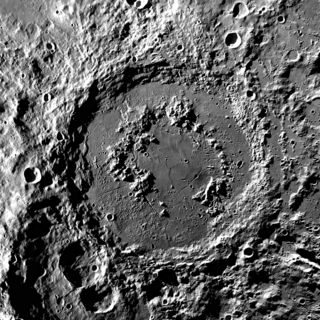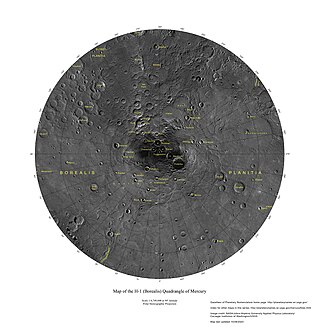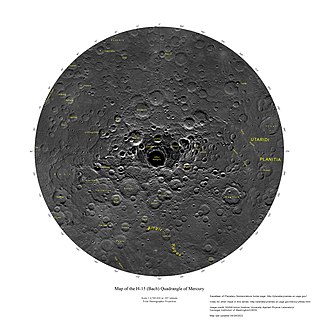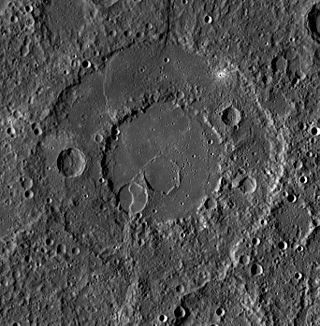Examples
- Barton crater, a peak-ring crater on Venus
- Schrödinger, a peak-ring crater on the Moon
A peak ring crater is a type of complex crater, which is different from a multi-ringed basin or central-peak crater. A central peak is not seen; instead, a roughly circular ring or plateau, possibly discontinuous, surrounds the crater's center, with the crater rim still farther out from the center.
The rings form by different processes, and inner rings may not be formed by the same processes as outer rings. [1]
It has long been the view that peak rings are formed in the stage subsequent to central peak formation in craters, with the stage being dependent on the crater diameter and planetary gravity. The central peaks of craters are believed to originate from hydrodynamic flow of material lifted by inward-collapsing crater walls, while impact-shattered rock debris is briefly turned to fluid by strong vibrations that develop during crater formation. The peak-ring structure of Chicxulub crater was probably formed as inward-collapsing material struck the over-steepened central peak, to form a hydraulic jump at the location where the peak ring was located. [2]
Other hypotheses have been formulated. Perhaps, in the case of Chicxulub crater, an over-high central peak collapsed into the peak ring. [3] [4]
Chicxulub is Earth's only crater to have an intact peak ring structure. [5] The Carswell crater in Saskatchewan, Canada, may also be an eroded peak ring crater. [6]
On Mercury:
On Earth:
On the Moon:

An impact crater is a depression in the surface of a solid astronomical body formed by the hypervelocity impact of a smaller object. In contrast to volcanic craters, which result from explosion or internal collapse, impact craters typically have raised rims and floors that are lower in elevation than the surrounding terrain. Impact craters are typically circular, though they can be elliptical in shape or even irregular due to events such as landslides. Impact craters range in size from microscopic craters seen on lunar rocks returned by the Apollo Program to simple bowl-shaped depressions and vast, complex, multi-ringed impact basins. Meteor Crater is a well-known example of a small impact crater on Earth.

An impact event is a collision between astronomical objects causing measurable effects. Impact events have been found to regularly occur in planetary systems, though the most frequent involve asteroids, comets or meteoroids and have minimal effect. When large objects impact terrestrial planets such as the Earth, there can be significant physical and biospheric consequences, as the impacting body is usually traveling at several kilometres a second, though atmospheres mitigate many surface impacts through atmospheric entry. Impact craters and structures are dominant landforms on many of the Solar System's solid objects and present the strongest empirical evidence for their frequency and scale.

The Chicxulub crater is an impact crater buried underneath the Yucatán Peninsula in Mexico. Its center is offshore, but the crater is named after the onshore community of Chicxulub Pueblo. It was formed slightly over 66 million years ago when a large meteorite, about ten kilometers in diameter, struck Earth. The crater is estimated to be 200 kilometers in diameter and 20 kilometers in depth. It is the second largest confirmed impact structure on Earth, and the only one whose peak ring is intact and directly accessible for scientific research.

Mare Orientale is a lunar mare. It is located on the western border of the near side and far side of the Moon, and is difficult to see from an Earthbound perspective. Images from spacecraft have revealed it to be one of the most striking large scale lunar features, resembling a target ring bullseye.

Carswell is an impact structure within the Athabasca Basin of the Canadian Shield in northern Saskatchewan, Canada. It is 39 kilometres (24 mi) in diameter and the age is estimated to be 115 ± 10 million years. The impact structure is exposed at the surface.

Schrödinger is a large lunar impact crater of the form traditionally called a walled plain and is named after Erwin Schrödinger. It is located near the south lunar pole on the far side of the Moon, and can only be viewed from orbit.

Silverpit crater is a buried sub-sea structure under the North Sea off the coast of the island of Great Britain. The 20 km (12 mi) crater-like form, named after the Silver Pit—a nearby sea-floor valley recognized by generations of fishermen—was discovered during the routine analysis of seismic data collected during exploration for gas in the Southern North Sea Sedimentary Basin.

H. Jay Melosh was an American geophysicist specialising in impact cratering. He earned a degree in physics from Princeton University and a doctoral degree in physics and geology from Caltech in 1972. His PhD thesis concerned quarks. Melosh's research interests include impact craters, planetary tectonics, and the physics of earthquakes and landslides. His recent research includes studies of the giant impact origin of the Moon, the Chicxulub impact that is thought to have extinguished most dinosaurs, and studies of ejection of rocks from their parent bodies. He was active in astrobiological studies that relate chiefly to the exchange of microorganisms between the terrestrial planets.

The Lac Wiyâshâkimî, also called the Clearwater Lakes in English and Allait Qasigialingat by the Inuit, are a pair of annular lakes and impact structures on the Canadian Shield in Quebec, Canada, near Hudson Bay.

The Borealis quadrangle is a quadrangle on Mercury surrounding the north pole down to 65° latitude. It was mapped in its entirety by the MESSENGER spacecraft, which orbited the planet from 2008 to 2015, excluding areas of permanent shadow near the north pole. Only approximately 25% of the quadrangle was imaged by the Mariner 10 spacecraft during its flybys in 1974 and 1975. The quadrangle is now called H-1.

The Tolstoj quadrangle in the equatorial region of Mercury runs from 144 to 216° longitude and -25 to 25° latitude. It was provisionally called "Tir", but renamed after Leo Tolstoy by the International Astronomical Union in 1976. Also called Phaethontias.

The Bach quadrangle encompasses the south polar part of Mercury poleward of latitude 65° S. It is named after the prominent crater Bach within the quadrangle, which is in turn named after Baroque composer Johann Sebastian Bach. The quadrangle is now called H-15.

The Beethoven quadrangle is located in the equatorial region of Mercury, in the center of the area imaged by Mariner 10. Most pictures of the quadrangle were obtained at high sun angles as the Mariner 10 spacecraft receded from the planet. Geologic map units are described and classified on the basis of morphology, texture, and albedo, and they are assigned relative ages based on stratigraphic relations and on visual comparisons of the density of superposed craters. Crater ages are established by relative freshness of appearance, as indicated by topographic sharpness of their rim crests and degree of preservation of interior and exterior features such as crater floors, walls, and ejecta aprons. Generally, topography appears highly subdued because of the sun angle, and boundaries between map units are not clearly defined.

Suevite is a rock consisting partly of melted material, typically forming a breccia containing glass and crystal or lithic fragments, formed during an impact event. It forms part of a group of rock types and structures that are known as impactites.

Raditladi is a large impact crater on Mercury with a diameter of 263 km. Inside its peak ring there is a system of concentric extensional troughs (graben), which are rare surface features on Mercury. The floor of Raditladi is partially covered by relatively light smooth plains, which are thought to be a product of the effusive volcanism. The troughs may also have resulted from volcanic processes under the floor of Raditladi. The basin is relatively young, probably younger than one billion years, with only a few small impact craters on its floor and with well-preserved basin walls and peak-ring structure. It is one of 110 peak ring basins on Mercury.

Complex craters are a type of large impact crater morphology. Complex craters are classified into two groups: central-peak craters and peak-ring craters. Peak-ring craters have diameters that are larger in than central-peak craters and have a ring of raised massifs which are roughly half the rim-to-rim diameter, instead of a central peak.

Rachmaninoff is an impact crater on Mercury. This basin, first imaged in its entirety during MESSENGER's third Mercury flyby, was quickly identified as a feature of high scientific interest, because of its fresh appearance, its distinctively colored interior plains, and the extensional troughs on its floor. The morphology of Rachmaninoff is similar to that of Raditladi, which is one of the youngest impact basins on Mercury. The age of Raditladi is estimated at one billion years. Rachmaninoff appears to be only slightly older.

Renoir is a crater on the planet Mercury. Its name, after the French painter Pierre-Auguste Renoir (1841–1919), was adopted by the International Astronomical Union in 1976.

A multi-ringed basin is not a simple bowl-shaped crater, or a peak ring crater, but one containing multiple concentric topographic rings; a multi-ringed basin could be described as a massive impact crater, surrounded by circular chains of mountains resembling rings on a bull's-eye. A multi-ringed basin may have an area of many thousands of square kilometres.